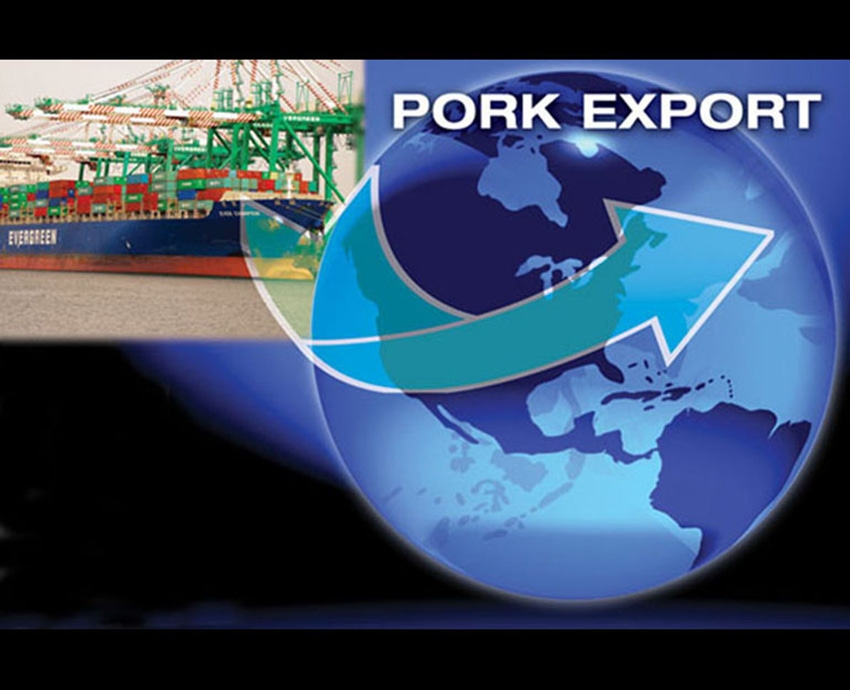While the Trump administration has pulled the U.S. out of the Trans-Pacific Partnership and started renegotiation of the North American Free Trade Agreement, the National Pork Producers Council is working hard to maintain or expand pork export markets.
August 11, 2017

If the sports world saying that defense makes the best offense holds true, U.S. pork producers should be sitting pretty.
Export markets are big factors for the entire U.S. economy, and U.S. pork producers look to foreign markets to purchase pork product; currently about 27% of total U.S. pork production finds its way to foreign markets.
The National Pork Producers Council looks to maintain and improve the amount of U.S. pork finding its way onto international tables, but that is proving more difficult with the Trump administration looking to make America great again by renegotiating or pulling out of trade deals.
“We (NPPC) are playing defense right now,” says Nick Giordano, NPPC vice president and counsel for Global Government Affairs, in light of the Trump administration following through on campaign promises to pull out of the Trans-Pacific Partnership and to renegotiate the North American Free Trade Agreement. In an NPPC press release it was stated that under TPP, which was strongly supported by the NPPC, Japan’s tariffs on pork, which are determined through a so-called gate price system, would have been nearly eliminated. Economist Dermot Hayes of Iowa State University estimates that U.S. pork exports to Japan would have increased exponentially under TPP, creating more than 5,000 new U.S. jobs.
The Japanese market, and all of Asia, is a potential growth market for U.S. pork, but that potential was put in jeopardy with the recent announcement that the European Union and Japan have reached agreement in principle on a trade pact. Upon that news, the NPPC renewed its request for the Trump administration to begin negotiations on a free trade agreement with Japan. NPPC was the first organization to go public requesting a bilateral agreement with Japan in February when Trump announced the United States would be pulling out of TPP.
Giordano says the United States currently has free trade agreements with 20 countries, and the U.S. pork trade with those 20 countries clearly indicates the importance of such FTAs. “We do more business with those 20 countries than the rest of the 100 countries that we do business with combined. … and these do not include Japan and China, so that just shows how successful these FTAs have been.”
“We’d like Japan to be No. 21,” he says. The EU-Japan agreement is a great concern to the NPPC and U.S. pork producers, as that deal “would likely be implemented in January of 2019, if not before. … that will impact U.S. pork producers, U.S. agriculture and that’s going to impact on a wider scale other sectors of the economy because Japan will be giving preferences to the EU that we don’t get, and as a nation that makes us less competitive.”
“This agreement really drives home the importance of market access and helps illustrate why the U.S. meat industry was so supportive of the Trans-Pacific Partnership,” says U.S. Meat Export Federation Economist Erin Borror, speaking of the EU-Japan partnership. “With the EU and our other major competitors moving so aggressively in their trade negotiations, TPP was needed just to keep pace, as U.S. pork will soon face a tariff disadvantage on certain products compared to its largest competitor in Japan.”
Globally speaking, according to Giordano, the U.S. pork industry is a low-cost producer, “so it’s an affordable product, and arguably the safest and highest-quality product in the world; we’re really well-positioned to compete, but the problem is that when trade deals are cut that don’t include us, that makes us less competitive. That’s a problem, and it’s a problem for more than just the pork industry.”
As an economy, in 2015 47% of all U.S. exports went to FTA partners, again reinforcing the importance of FTAs.
As stated before, exports are a big deal for U.S. pork producers as over a quarter of production finds its way into foreign markets.
“This comes at the worst possible time as we have new plants coming online and producers are in expansion mode,” Giordano says of the potential trade disruptions. “Hog production in the U.S. has been on an upward trajectory, and new plants indicate that we have a world-class healthy and growing pork industry. You have to think that exports had a bearing on these decisions being made.”
Domestic demand cannot eat up the increased production and the new processing plants coming online will not want to operate at less than capacity, so a strong export market is imperative, whether it’s a deal with Japan, a renegotiated NAFTA or a deal with other countries.
“We’re export dependent,” Giordano says, and for that reason the NPPC “worked real hard with others to make sure that the notice to withdraw from NAFTA did not go out.”
Protection of existing export markets is the No. 1 priority for Giordano and the NPPC, �“and we’re always playing defense for our producers, and now we’re playing defense like never before not just because of NAFTA, but because of China in recent elections has been a lightning rod issue, and both presidential candidates called out China and its trade practices.”
Giordano realizes that pork producers are not the only national interest when talking global trade, and that was evident with the NPPC recently joining forces with 17 other food and agriculture organizations, representing the vast majority of production agriculture, urging the Trump administration to refrain from placing restrictions on imports of steel and aluminum. The organizations are very concerned that such restrictions will boomerang against U.S. food and agriculture exports.
What’s the connection between aluminum, steel and pork exports?
The groups warn that “the aftermath (of restrictions on steel and aluminum imports) could be disastrous for the global trading system and for U.S. agriculture in particular.” The groups point out that many countries exporting the metals to the United States are also large importers of U.S. agricultural products. “The potential for retaliation from these trading partners is very real,” the groups say.
Under the 1994 General Agreement on Tariffs and Trade Article XXI, national security can be a legitimate reason to restrict trade, but it rarely is cited.
“No country can dictate another’s national security needs,” the organizations write, “so now every country with a sensitive industry would know that it could follow the example of the United States and find a national security reason to circumvent trade commitments, no matter how flimsy the reason might be.”
“The U.S. is globally competitive in all sectors, so this isn’t just a pork issue,” Giordano says. “You open Pandora’s Box. We’re not saying steel and aluminum should be ignored, we’re just saying let’s be careful how we deal with one problem and don’t fix one problem but create a heck of a lot more problems.”
Horace Greeley may have urged young men to “Go West,” but Giordano says the pork industry is looking to the East.
“Our mantra has been it’s all about the Asia-Pacific region beginning with Japan, because it’s the fastest growing region of the world, and next would be Vietnam,” he says. “EU is beating the U.S. to the punch, as Vietnam got a deal with the EU last year and the Japan-EU agreement should be in place by January 2019.”
Giordano says the third part, or pieces of the export puzzle are those countries that may not be ready for an FTA with the United States, “but we are working to identify those countries to get into those markets.” One such market is India, which sends a lot of products to the U.S. without tariffs, and “yes some here do benefit from that, but India gets trade preference. … India holds more promise for U.S. dairy and poultry than for U.S. pork, but I have been there, and there is a market there for us, and we can sell pork there, and we need to be in that market. India will replace China as the largest country” in the future.
There are no guarantees, and that is definitely true in the export market, and “I can’t guarantee to producers that we will not have problems in an export market,” Giordano says, “but I can guarantee that we are working our tails off to make sure that doesn’t happen.”
You May Also Like



